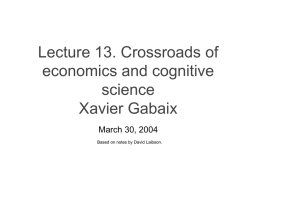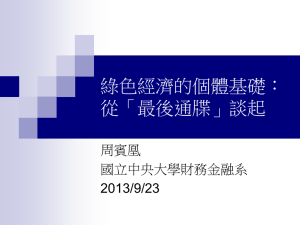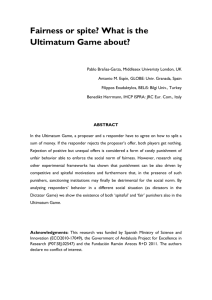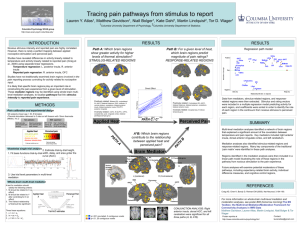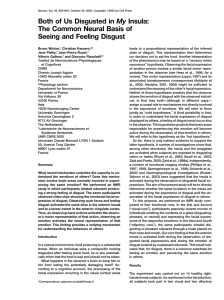14.127 Lecture 8. Crossroads of economics and cognitive science Xavier Gabaix
advertisement
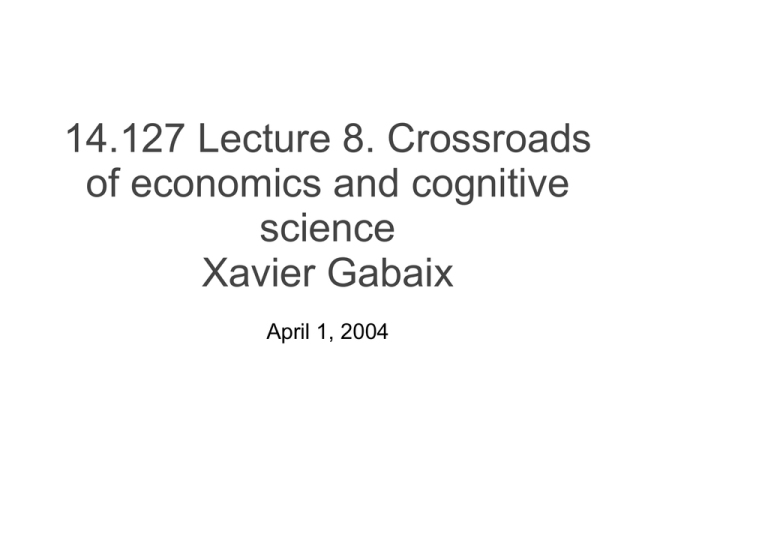
14.127 Lecture 8. Crossroads of economics and cognitive science Xavier Gabaix April 1, 2004 Ultimatum Game 1. Proposer (P) proposes x 2. Receiver (R) accepts or rejects 3. If R rejected both get 0, if R accepted, R gets x, and P gets 10-x Sanfey and Cohen’s ultimatum experiment (Sanfey et al 2003, Science, v. 300, p. 1755) • 30 subjects neuroimaged (fMRI) in the responder position of the ultimatum game • Particular neural loci are disproportionately activated when subjects receive unfair offers from humans (as opposed to fair offers from humans or fair and unfair offers from computers) – – – Bilateral anterior insula Anterior cingulate cortex Right dorsolateral prefontal cortex • Disproportionate right anterior insula activation correlates with the decision to reject unfair offers from humans (affective neural locus) Reveal Partner Reveal Fixation Reveal Offer Reveal Options Reveal Outcome Kelly gets $8 Kelly gets $0 Accept Reject You get $2 You get $0 + 12 sec 6 sec 6 sec 6 sec Subject Decides A Acceptance Rates 6 sec 100 90 80 70 60 50 40 30 20 10 0 $5:$5 $7:$3 $8:$2 Offer B $9:$1 Human Computer A) Time line for a single round of the Ultimatum Game. B) Behavioral results from the Ultimatum Game. Images adapted from Sanfey, et al. "The Neural Basis of Economic Decision-Making in the Ultimatum Game." Science 300 (2003): 1755-1758. R. Anterior Insula (Contrast Values) 2 1.5 1 0.5 0 -0.5 0 20 40 60 80 100 Acceptance Rates(%) A 1.2 Contrast Values 1 0.8 0.6 0.4 0.2 0 R. Anterior Insula R. DLPFC B Accepted Rejected (A) Acceptance rates of unfair offers plotted against right anterior insula activation for each participant. (B) Right anterior insula and right DLPFC activation for all unfair offer trials, categorized by subsequent acceptance or rejection. McClure, Laibson, Loewenstein, and Cohen 2004 – Do consumers think differently about immediate rewards and delayed rewards? – Does immediacy have a special emotional drive/reward component? – Methodology: Give subjects choices over pairs of rewards. • $5 gift certificate at time t or $10 gift certificate at t’>t – Look for differential activation when immediacy is present (i.e., when t=0). Q: Which regions of the brain are differentially activated when a subject considers an immediate reward (relative to consideration of a delayed reward)? A: Limbic regions and projections from the limbic system. In other words, emotional systems are activated by immediacy. Preferences: • Why do preferences vary across individuals? 1. Experiential (especially in early life) – ‘motherless’ monkeys, infant rats handled by humans (Ferris) – songbird brains affected by exposure to specie-specific songs – chronic drug use 2. Genetic – – – – – – family, twin and adoption studies support genetic component in drug abuse vulnerability and ongoing drug dependence (Gardner) most phenotypes show around 50% heritability (controversial; see Dickens) breeding for behavioral dispositions Lewis rat strain exhibits polydrug preference (e.g., ethanol, nicotine, opiates, cocaine); related to dysfunction in DA regulation in DA forebrain reward system (Gardner) (same DA dysfunction can be induced by chronic drug use) violence: suicide, delinquent anti-social and criminal behavior (Coccaro); low serotonin? • How do preferences change over time (intrapersonal variation)? 1. Long-run variations: drug use → (a) decreased DA synthesis (b) depletion of extracellular DA (c) withdrawal and tolerance; u(c-x) 2. Short-run variations (a) cue-based cravings (Siegel; Laibson; Bernheim and Rangel) (b) cue-contingent tolerance (Siegel) (c) conditioned responses (Pavlov) (d) ‘visceral’ responses (Loewenstein) (e) expectancy-based cravings (Schultz) (f) estrogen in punishment games (Fehr) 3. lifecycle variation (a) age declines in BSR and DA (Gardner) • What are the carriers of utility? symbols ($$$) cues expectancies } DA (excitatory or inhibitory) (Berridge, Schultz, Gardner, Shizgal) • Can we measure preferences without revealed preference? – left/right brain asymmetry (Kahneman) – real time mood measures – extracellular DA? – genotypes • How well do we know our own preferences? – peak-end effects (Kahneman) – decision utility vs. experienced utility (Kahneman) – affect system – dual process models (inaccessible emotional motives) • How can we change preferences? – Prozac? 1990’s bull market?! – Cognitive behavioral therapies. • New tools to measure cognition processes – EEG, PET, fMRI (learning application) – visors for measuring visual focus – mouselab – software that allows to see what information people collect before taking decision Authors who have written papers that belong in this class: • Loewenstein (visceral effects) • Kahneman (imperfect memory) • Laibson (conditioned cue-initiated appetites) • Romer (conditioned appetites) • Mullainathan (imperfect memory) • Gul and Pesendorfer (choice based appetites) • Benabou and Tirole (memory technologies) • Bernheim and Rangel (conditioned visceral effects) • Camerer and Loewenstein (JEP overview)
